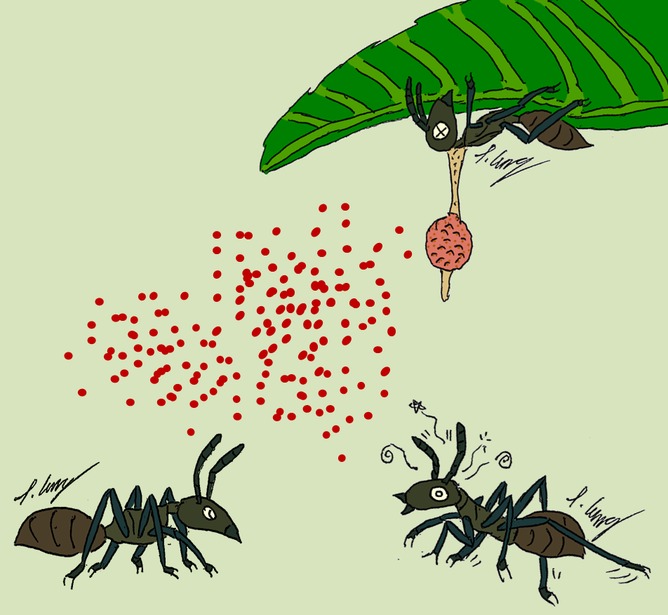
Meet the Enemy of Killer Fungus that Turns Ants into Zombies

This article was originally published at The Conversation. The publication contributed the article to LiveScience's Expert Voices: Op-Ed & Insights.
One of most famous fungi in the world is the “zombie ant fungus”. It takes over the mind of an ant, causing it to climb up a branch and cling to the underside of a leaf before mummification. Once locked in place, the mushroom-like fruiting body of the cordyceps sprouts from the ant and eventually releases its spores.
This ant-killing fungus goes by the scientific name Ophiocordyceps unilateralis and its modus operandi has made it something of a celebrity – inspiring an episode of the X files, the video game The Last of Us and even a Pokémon character.
This fame might make it seem there is just one fungus that can create such a nightmare. But in fact there are many species of them, and zombifying ants is not their only speciality.
In just the Ophiocordyceps genus there are more than 100 species. Many insects can fall under their spell – beetles, caterpillars, cicada and dragonflies are all fair game. There is fossil evidence indicating that this has been going on for more than 40m years. But while these fungi are master body-snatchers, they don’t always get everything to themselves. Sometimes two of these fungi can infect the same ant.
Last month scientists in Japan studying these fungi started noticing that some zombified ants were afflicted with two distinct forms of cordyceps fungi. Both fungi were found sprouting from dead ants that had their mandibles clamped tightly around a branch in the typical zombie-ant pose. One fungus species, O. pulvinata, produces a bulbous fruiting body that juts from the back of the ant’s head. The other, O. sessilis, covers the ant’s body in spiny fruiting bodies.
There is nothing peculiar about that as cordyceps come in many different shapes, but what stood out was that they also noticed O. sessilis is only ever found in ants that are also infected with O. pulvinata. Rather than a case of a pair of fungi cozily sharing the same host, the scientists suggested that O. sessilis is actually a parasite of O. pulvinata itself.
Sign up for the Live Science daily newsletter now
Get the world’s most fascinating discoveries delivered straight to your inbox.
This is an example of hyperparasitism – whereby a parasite itself becomes infected by a parasite. Jonathan Swift was on to something in his oft-misquoted poem:
So, naturalists observe, a flea Hath smaller fleas that on him prey And these have smaller fleas to bite ‘em And so proceed ad infinitum.
The behaviour is observed in other parasites. For instance, parasitic barnacles that castrate crabs can in turn be infected with their own castrating parasite and salmon lice are sometimes infected with microsporidian parasites.
Switching hosts from an insect to another fungi (or vice versa) seems to be fairly common among cordyceps fungi. And there may be an evolutionary reason for this adaptation.
The microscopic spores of a fungus get inside the insect by puncturing their tough exoskeleton. This is done by secreting enzymes that dissolve chitin, which happens to be the same material that makes up the cell wall of fungi. So any fungus able to chew through an insect’s exoskeleton is already equipped to attack other fungi.
But apart from enemies within the cordyceps, the zombie ant fungus also faces threats from other types of hyperparasitic fungi. After the cordyceps has moved the zombified ant into the ideal position, the spore-producing fruiting body punches through the host’s exoskeletal shell and takes at least two weeks to reach maturity. During that time, it is vulnerable to spores of other types of fungi that specialise in taking over cordyceps, covering it in a dense white mould and rendering it sterile.
Usually the enemy of an enemy is a friend, but that is of no consequence for a zombified ant. To these fungi the ant is but a stage upon which they play out their lives and conflicts, as they have been doing for millions of years.
Tommy Leung does not work for, consult to, own shares in or receive funding from any company or organisation that would benefit from this article, and has no relevant affiliations.
This article was originally published at The Conversation. Read the original article. The views expressed are those of the author and do not necessarily reflect the views of the publisher. This version of the article was originally published on LiveScience.










